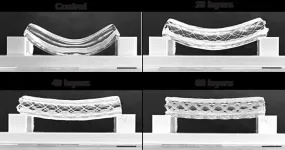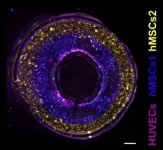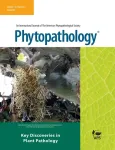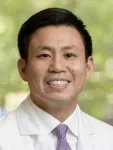(Press-News.org) In this project volumetric bioprinting was for the first time successfully combined with melt electrowriting. This combines the speed and cell-friendliness of volumetric printing with the structural strength needed to create functional blood vessels. The study by the biofabrication lab of Regenerative Medicine Center Utrecht (RMCU) was published today in Advanced Materials.
Volumetric printing is a technique that was pioneered for bioprinting by the RMCU biofabrication lab in 2019. It is a fast technique, which allows cells to survive the printing process. However, because this type of printing is done in cell-friendly gels, the resulting prints are structurally not very sound. This is a problem for blood vessels, which have to be able to withstand high pressures and bending. For this reason, a merger of volumetric bioprinting and melt electrowriting was pursued.
Melt electrowriting is a highly accurate type of 3D printing that works by directing a narrow filament of molten (biodegradable) plastic. It’s able to produce intricate scaffolds that are mechanically strong and able to deal with force. The downside here is that they can’t be printed with cells in there directly, because of the high temperatures involved. Therefore, volumetric bioprinting was used here to solidify cell-laden gels onto the scaffolds.
How to merge electrowriting with volumetric printing
The process starts with the creation of a tubular scaffold using melt electrowriting. This is then submerged into a vial with photoactive gel and placed in the volumetric bioprinter. In principle, the laser of the printer can selectively solidify the gel that sits in, on and/or around the scaffold. “In order to get this right, we had to place the scaffold exactly center in the vial,” first author Gabriël Größbacher says. “Any deviation from the center would mean that the volumetric print would be off-set. But we managed to center it perfectly by printing the scaffold on a mandril that we fitted to the vial.”
In this study, Größbacher and colleagues tested various thicknesses of the scaffold, which resulted in more or less strong tubes. Finally, they also tested various placements of the bioprinted gels. These could either be placed on the inner side of the scaffold, inside the scaffold itself or on the outside of it. By using two differently labeled stem cells, the team was able to print a proof of principle blood vessel with two layers of stem cells, and seeded epithelial cells in the center to cover the lumen of the vessel.
From tubes to functional vessels
The design could also allow for holes in the side of the print, giving the possibility for controlled permeability of the vessel for the blood to do its function. Finally, the researchers also created more complex structures like forked vessels, and even vessels with venous valves that were functional in maintaining a unidirectional flow.
Größbacher: “This was a proof of principle study. What we now need to do is replace the stem cells with functional cells that are part of a real blood vessel. That means adding muscle cells and fibrous tissue around the epithelial cells. Our goal now is to print a functional blood vessel.”
END
Combining bioprinting techniques to pursue functional blood vessels
UMC Utrecht researchers for the first time successfully combined volumetric bioprinting with melt electrowriting. This combines the speed and cell-friendliness of volumetric printing with the structural strength needed to create functional blood vessels.
2023-06-07
ELSE PRESS RELEASES FROM THIS DATE:
Leading plant science journal publishes a special issue on key discoveries in plant pathology
2023-06-07
In just 7 years, the Irish Potato Famine caused approximately one million people to starve to death and forced another estimated million to flee Ireland as refugees. A mold called Phytophthora infestans infected Ireland’s potato crop, a staple food, and spread rapidly throughout the island. The seemingly tiny fungus destroyed roughly 75% of potato crops over the duration of the great hunger. This catastrophic famine, along with several others in various parts of the world throughout history, highlighted the critical need for the study of plant diseases.
Decades ...
Autonomous products like robot vacuums make our lives easier. But do they deprive us of meaningful experiences?
2023-06-07
Researchers from University of St. Gallen and Columbia Business School published a new Journal of Marketing article that examines how the perceived meaning of manual labor can help predict the adoption of autonomous products.
The study, forthcoming in the Journal of Marketing, is titled “Meaning of Manual Labor Impedes Consumer Adoption of Autonomous Products” and is authored by Emanuel de Bellis, Gita Venkataramani Johar, and Nicola Poletti.
Whether it is cleaning homes or mowing lawns, consumers increasingly delegate manual tasks to autonomous products. These gadgets operate without human oversight and free consumers from ...
Paul Ellison, PhD, receives SNMMI Mars Shot Fund award
2023-06-07
Reston, Virginia—The SNMMI Mars Shot Research Fund is excited to announce that Paul Ellison, PhD, assistant professor at the Department of Medical Physics at the University of Wisconsin School of Medicine and Public Health in Madison, has been selected as the recipient of a $500,000 grant from the 2023 Mars Shot Fund. The grants recognize individuals who have made transformative impact in the field and elevated the value of nuclear medicine and molecular imaging.
The grant is one of five awarded in the inaugural year of the new SNMMI Mars Shot Research Fund, which ...
Amir Iravani, MD, receives SNMMI Mars Shot Fund award
2023-06-07
Reston, Virginia—The SNMMI Mars Shot Research Fund is excited to announce that Amir Iravani, MD, associate professor of radiology in the Department of Radiology at the University of Washington School of Medicine in Seattle, Washington, has been selected as the recipient of a $1,000,000 SNMMI Mars Shot Fund Grant. The grants recognize individuals who have made transformative impact in the field and elevated the value of nuclear medicine and molecular imaging.
The grant is one of five awarded in the inaugural year of the new SNMMI Mars Shot Research Fund, which was established to provide resources that translate visionary nuclear medicine imaging, radiopharmaceutical therapy ...
Craig Levin, PhD, receives SNMMI Mars Shot Fund award
2023-06-07
Reston, Virginia—The SNMMI Mars Shot Research Fund is excited to announce that Craig Levin, PhD, professor of radiology, physics, electrical engineering and bioengineering at Stanford University in Stanford, California, has been selected as the recipient of a $500,000 grant from the 2023 Mars Shot Fund. The grants recognize individuals who have made transformative impact in the field and elevated the value of nuclear medicine and molecular imaging.
The grant is one of five awarded in the inaugural year of the new SNMMI Mars Shot Research Fund, which was established to provide ...
Julie Sutcliffe, PhD, receives SNMMI Mars Shot Fund award
2023-06-07
Reston, Virginia—The SNMMI Mars Shot Research Fund is excited to announce that Julie Sutcliffe, PhD, professor of internal medicine and biomedical engineering, University of California–Davis, has been selected as the recipient of a $500,000 grant from the 2023 Mars Shot Fund. The grants recognize individuals who have made transformative impact in the field and elevated the value of nuclear medicine and molecular imaging.
The grant is one of five awarded in the inaugural year of the new SNMMI Mars Shot Research Fund, which was established to provide ...
Randy Yeh, MD, receives SNMMI Mars Shot Fund award
2023-06-07
Reston, Virginia—The SNMMI Mars Shot Research Fund is excited to announce that Randy Yeh, MD, a radiologist and nuclear medicine physician at Memorial Sloan Kettering Cancer Center and assistant professor of radiology at Weill Cornell Medical College in New York, has been selected as the recipient of a $500,000 grant from the 2023 Mars Shot Fund. The grants recognize individuals who have made transformative impact in the field and elevated the value of nuclear medicine and molecular imaging.
The grant is one of five awarded in the inaugural year of the new SNMMI Mars Shot Research Fund, which ...
Investigating the placenta: Discovery from Stowers Scientists shows why this often-overlooked organ should be given more attention
2023-06-07
KANSAS CITY, MO—June 7, 2023—The placenta, critical for healthy embryo development, is a multi- purpose organ with a precise lifespan—the length of a pregnancy. New research from the Stowers Institute for Medical Research suggests that further exploration of the placenta’s roles and capabilities may one day lead to insights for positive pregnancy outcomes.
The study published in Development on June 6, 2023, focuses on a unique property of many cells comprising the placenta that explains how these cells perform essential functional and physical ...
Remnants of ancient virus may fuel ALS in people
2023-06-07
More than 5,000 people are diagnosed annually with ALS (amyotrophic lateral sclerosis), a fatal, neurodegenerative disease that attacks nerve cells in the brain and spinal cord, gradually robbing people of the ability to speak, move, eat and breathe.
To date, only a handful of drugs exist to moderately slow its progression. There is no cure.
But CU Boulder researchers have identified a surprising new player in the disease—an ancient, virus-like protein best known, paradoxically, for its essential role in enabling placental development.
The findings ...
Lack of timely follow-up after heart failure hospitalization for most adults with diabetes
2023-06-07
Research Highlights:
58% of adults with Type 2 diabetes covered by Alabama Medicaid did not receive prompt outpatient care after hospitalization for heart failure.
African American and Hispanic adults with Type 2 diabetes were less likely to have post-discharge follow-up health visits, or if they did, the visits occurred nearly two to three days later compared to white adults.
Embargoed until 4 a.m. CT/5 a.m. ET Wednesday, June 7, 2023
DALLAS, June 7, 2023 — More than half of Medicaid-covered adults in Alabama with Type 2 diabetes did not receive follow-up health care within the recommended two-week period following hospitalization for newly-diagnosed heart ...
LAST 30 PRESS RELEASES:
Revealing the cell’s nanocourier at work
Health impacts of nursing home staffing
Public views about opioid overdose and people with opioid use disorder
Age-related changes in sperm DNA may play a role in autism risk
Ambitious model fails to explain near-death experiences, experts say
Multifaceted effects of inward foreign direct investment on new venture creation
Exploring mutations that spontaneously switch on a key brain cell receptor
Two-step genome editing enables the creation of full-length humanized mouse models
Pusan National University researchers develop light-activated tissue adhesive patch for rapid, watertight neurosurgical sealing
Study finds so-called super agers tend to have at least two key genetic advantages
Brain stimulation device cleared for ADHD in the US is overall safe but ineffective
Scientists discover natural ‘brake’ that could stop harmful inflammation
Tougher solid electrolyte advances long-sought lithium metal batteries
Experts provide policy roadmap to reduce dementia risk
New 3D imaging system could address limitations of MRI, CT and ultrasound
First-in-human drug trial lowers high blood fats
Decades of dredging are pushing the Dutch Western Scheldt Estuary beyond its ecological limits
A view into the innermost workings of life: First scanning electron microscope with nanomanipulator inaugurated in hesse at Goethe University
Simple method can enable early detection and prevention of chronic kidney disease
S-species-stimulated deep reconstruction of ultra-homogeneous CuS nanosheets for efficient HMF electrooxidation
Mechanical and corrosion behavior of additively manufactured NiTi shape memory alloys
New discovery rewrites the rules of antigen presentation
Researchers achieve chain-length control of fatty acid biosynthesis in yeast
Water interactions in molecular sieve catalysis: Framework evolution and reaction modulation
Shark biology breakthrough: Study tracks tiger sharks to Maui mating hub
Mysterious iron ‘bar’ discovered in famous nebula
World-first tool reduces harmful engagement with AI-generated explicit images
Learning about public consensus on climate change does little to boost people’s support for action, study shows
Sylvester Cancer Tip Sheet for January 2026
The Global Ocean Ship-Based Hydrographic Investigations Program (GO-SHIP) receives the Ocean Observing Team Award
[Press-News.org] Combining bioprinting techniques to pursue functional blood vesselsUMC Utrecht researchers for the first time successfully combined volumetric bioprinting with melt electrowriting. This combines the speed and cell-friendliness of volumetric printing with the structural strength needed to create functional blood vessels.








